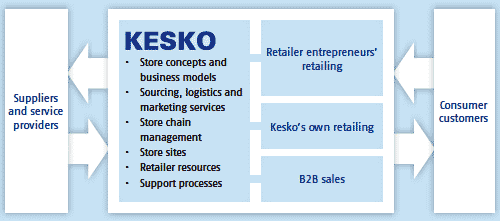Frontpage ![]() Year 2009
Year 2009 ![]() Strategic objectives
Strategic objectives

Kesko is a highly valued listed trading sector company. It manages retail store chains that are valued by customers and efficiently produces services for retail store chains’ purchasing, logistics, network development and data management. Kesko’s operations include food, home and speciality goods, building and home improvement, and car and machinery trade. Its division parent companies and chains act in close cooperation with retailer entrepreneurs and other partners. Kesko operates in the Nordic and Baltic countries, Russia, and Belarus.

Kesko’s key strategic objectives in all store chains include achieving a level of customer satisfaction and sales growth that exceeds the level achieved by competitors. Shareholder value is increased by long-term profitable growth. Objectives also include maintaining good solvency and liquidity in all market conditions. The target return on equity is 12%, while the target return on capital employed is 14%.
The objective is to invest in healthy, profitable growth, while taking the market situation and customer demand into consideration.
Investments in the food trade are directed at expanding and refurbishing the store network in Finland. In addition, expanding business to the Russian market is studied.
In the building and home improvement trade, the international store network will be expanded in the next few years mainly in Russia, with the focus on the retailing markets of the St. Petersburg and Moscow regions. In addition to investments in new store sites, business growth may also be achieved through acquisitions. The Russian market in particular is considered to offer significant long-term growth potential in the home building and decoration trade. Synergy benefits are achieved through joint category management and sourcing, which are supported by investments in the joint enterprise resource planning system and centrally directed logistics network.
The strategic emphasis lies on sales to consumer customers. The objective is to achieve a level of customer satisfaction and sales growth that exceeds the level achieved by competitors. Success in the consumer customer trade requires clear customer and brand promises and the fulfilment of these promises during every store visit.
Customer promises are fulfilled through high-quality and competitively-priced products, a comprehensive store network and good service.
Kesko has dozens of successful chain and product brands that are managed and developed according to customer needs. The objective of brand development work is to increase the value of brands and to improve the efficiency of marketing.
The creation of customer-driven selections and targeted marketing are supported by the K-Plussa customer loyalty system, whose reward and payment card features have undergone reforms in recent years. The K-Plussa customer loyalty programme operates on three levels: benefits granted to customers are either store-specific, chain-specific or provided across the entire K-Plussa network. The objective of the system is to offer significant product and service benefits to customers, encouraging them to centralise their purchases in the K-Group. The use of customer information has been enhanced in key business areas. Chains and stores utilise customer information in their selection planning, pricing, marketing and store network planning, for example.
| The objectives announced on 5 Feb. 2009 |
Target level | Realised in 2009 | Realised in 2008 |
| Net sales growth | Growth rate exceeding that of the market |
Realised*: Food trade, sports trade, building and home improvement trade (Finland), car and machinery trade |
Realised: VV-Auto, Intersport Finland, Kenkäkesko |
| Return on equity | 12% | 6.6%, excl. non-recurring items 3.8% |
12%, excl. non-recurring items 8.1% |
| Return on capital employed |
14% | 11.0%, excl. non-recurring items 7.3% |
14%, excl. non-recurring items 10.0% |
| Interest-bearing net debt/EBITDA |
< 3 | -0.7 | 0.1 |
| Equity ratio | 40–50% | 54% | 52% |
| Economic value added |
Growing positive EVA as internal indicator |
Not realised | Not realised |
The business models applied in Kesko’s sales to consumer customers are retailing through retailer entrepreneurs and Kesko’s own retailing. Kesko is also engaged in B2B sales.
The principal business model in the Finnish market is the chain business model, in which independent K-retailers run retail stores in chains managed by Kesko. In Finland, all food and building and home improvement stores in the K-Group are run by retailer entrepreneurs. Through its chain operations, Kesko provides a first-class setting for its retailer entrepreneurs to provide the best possible service to their customers. The K-retailer entrepreneur is responsible for his or her store’s customer satisfaction, personnel and business profitability. Good service and knowledge of customer needs provide the K-Group with a competitive edge.
At the end of 2009, Kesko had 1,302 K-retailer entrepreneurs as partners and, in addition, about 250 other retailer partners in the Asko, Sotka, Byggmakker and Senukai chains. Kesko’s sales to retailer partners accounted for 51% of net sales in 2009.
Kesko acts as a retailer in business operations where the competitive advantage derives from the centrally managed chain concept and large units. Kesko’s own retail stores in Finland include the Anttila and Kodin Ykkönen department stores. In addition, Kesko is also responsible for retailing home and speciality goods in the K-citymarket chain. Kesko’s own retailing is also the model mainly used in expanding business operations outside Finland. In 2009, Kesko’s own retailing accounted for 27% of net sales.
Kesko is engaged in B2B sales in those business operations in which B2B sales support consumer customer sales. Typical business customers include construction companies, agricultural entrepreneurs, the manufacturing industry, institutional kitchens and the public sector. In 2009, Kesko’s B2B sales accounted for 22% of net sales.
The importance of electronic customer communications in trading has increased continuously. Kesko is developing online customer communications and the chains’ online trading sites. The objective is to improve customer satisfaction and to increase sales. Kesko has gained a strong position in online sales of home and speciality goods through the NetAnttila, Kodin1.com, Konebox.fi and Budget Sport online stores.
The principles of sustainable development and responsible operating practices are a central part of Kesko’s and its chains’ daily activities. Consumer customers require the trading sector to take responsibility for products’ safety and health effects, and for the environmental and social impact of business operations. The results of responsible operations are reported annually in Kesko’s Corporate Responsibility Report.
Efficient combination of retailer entrepreneurship and chain operations and benefitting from economies of scale
The strategic objective is to efficiently combine K-retailer entrepreneurship and chain operations. K-retailers are responsible for customer service, local selections and fulfilling the customer promise in their stores.
Kesko’s efficient chain operations and joint processes provide support to retailers. Chain operations offer the retailer a joint business concept which includes, among other things, chain control related to chain selection, pricing and marketing, and business management support. Joint chain operations carried out by retailers and Kesko are further enhanced by developing increasingly better tools and business models for the stores. The most important of these are regional and store-specific selections and pricing guidance as well as tools for customer relationship and store personnel management.
Kesko participates in international purchasing cooperation in various product lines, which increases purchasing volumes and efficiency. The most important partnership organisations in which Kesko participates include AMS Sourcing B.V. in the grocery trade, tooMax-x in the building and home improvement trade, Intersport International Corporation in the sports trade, and Electronic Partner International in the home technology trade.
Cost-efficient operations build price competitiveness and customer satisfaction in the retailing sector. Cost-efficiency is also a basic requirement for increasing Kesko’s profitability and shareholder value.
One of the key objectives of the work and productivity programme launched is to increase employees’ work productivity in Kesko and the chain stores. The most important tools for improving productivity include increasing personnel competence and the efficiency of operating practices. Promoting the wellbeing of employees has also become an increasingly important factor. Retail stores also focus on enhancing the productivity of store space and inventories.
A project to automate processes and routines with the goal of improving cost-efficiency is underway in Kesko. Key areas in process automation include logistics automation projects, the forecast systems and automated orders that improve the availability of products in stores, the adoption of electronic purchase and sales invoices, and the automation of financial management routines in the shared services centre of the Kesko Group.
More detailed information on each division’s strategic emphases and projects is provided in the division-specific presentations in divisions section.